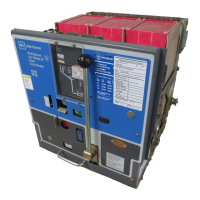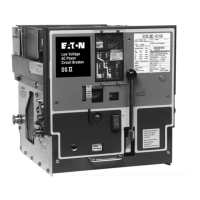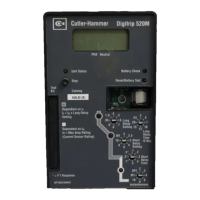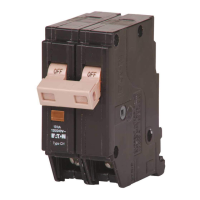Page 60
Each Amptector I-A trip unit has a terminal block
equipped with test plug terminals accessible on the front
of
the circuit breaker front panel. This permits convenient
field checking
of
calibrations and operation with an exter-
nal power supply. A specially designed power supply test
kit, with plugs to match the Amptector trip unit test plug
terminals is available; and its operation is described in
Section 8.7 6
of
this instruction book.
Figure 59 shows a typical standard wiring diagram, which
includes the Amptector trip unit terminal block.
The
fol-
lowing table explains the markings
of
the terminals:
A Sensor phase A
B Sensor phase B
C Sensor phase C
N Sensor neutral
G
Ground
OP Output positive *
ON Output negative*
DN Test point (internal neutral)**
DS Test point**
TP Test
point**
ass
High load switch signal to accessory unit
DI
Test
point**
*To Actuator Coil. THIS COIL HAS A POLARITY MARK-
ING ON THE POSITIVE LEAD WHICH
MUST
BE
OBSERVED. OTHERWISE THE BREAKER WILL
NOT
HAVE OVERLOAD
OR
FAULT PROTECTION WHICH
COULD RESULT
IN
BODILY INJURY AND/OR SERI-
OUS EQUIPMENT DAMAGE.
**Terminals marked "test point" are intended to provide
connections for operation
of
the optional test kit.
8.2.1
Ground Fault Protection
When the Amptector I-A trip unit includes ground current
protection, the type
of
connection to the circuit must be
considered.
If
the system neutral is grounded but the
neutral is not carried with the phase conductors, the
Amptector trip unit has all
of
the equipment necessary for
sensitive ground protection.
If
the system neutral is grounded and a neutral conductor
is carried with the phase conductors, it is necessary to
order an additional sensor, for the purpose
of
cancelling
out any residual current
in
the phase conductors. This
sensor must be mounted separately and must be located
on the neutral conductor
at
the point where the neutral
1.8. 33-790-11
conductor connects to the neutral bus. These sensors
are duplicate
of
those supplied on the breaker except for
the 2400A and 3200A ratings where a modified neutral
sensor is required.
The Amptector trip unit ground element may be ener-
gized from an external ground current source rather than
from internally developed ground current. Such an exter-
nal source could be a ring-type transformer through
which all
the load current conductors would have to pass.
In
the case
of
a three-phase four-wire circuit all three
phase conductors and the neutral conductors would have
to pass through the transformer. The sensitivity
of
the
ground element for this kind
of
arrangement would
depend on the ratio
of
the transformer used.
The ground current pick-up dial on the Amptector I-A trip
unit has alphabetic calibration markings. The actual
ground current corresponding to these calibrated points
varies with the rating
of
the sensor being used. These
pick-up values are printed on the top
of
the trip unit box.
The "Ground Trip Indicator'' is a metal plunger located
at
the upper right corner
of
the trip unit.
If
the trip unit has
functioned due to a ground fault, this plunger will protrude
through the faceplate
of
the unit. The indicator is reset by
pushing
in
on the plunger.
If
it is not reset before placing
the breaker back
in
service, the trip unit will function nor-
mally but there will remain a false indication.
Overload Trip Indicator - Functions due to overload cur-
rents less than short delay
or
instantaneous pick-up.
Short
Circuit
Trip Indicator - Functions due to fault cur-
rent
in
excess
of
short delay
or
instantaneous pick-up.
8.3 MAKING CURRENT RELEASE (DISCRIMINATOR)
All Amptector trip units which do not have instantaneous
trip elements (Amptector II-A model SE and Amptector
I-A models LS and LSG) are provided with a "making cur-
rent release" which is referred to
as
a "Discriminator''.
This is a circuit
in
the trip unit which determines
at
the
time
of
a fault whether
or
not there has been any current
flow in the primary circuit previous to the fault.
If
there
has been no measurable current flow previous to the
fault, indicating that the circuit breaker is
just
being
closed (or possibly that a switching device ahead
of
the
breaker has
just
been closed) and
if
the primary current
flow exceeds approximately twelve times the sensor rat-
ing, the trip unit will function instantaneously. If the "Dis-
criminator" circuit determines that there has been a
measurable current flow prior to the fault, the instanta-
neous operation will not occur and the normal short time
delay element will take over to delay tripping.
The
pur-
Effective October 1998
Courtesy of NationalSwitchgear.com

